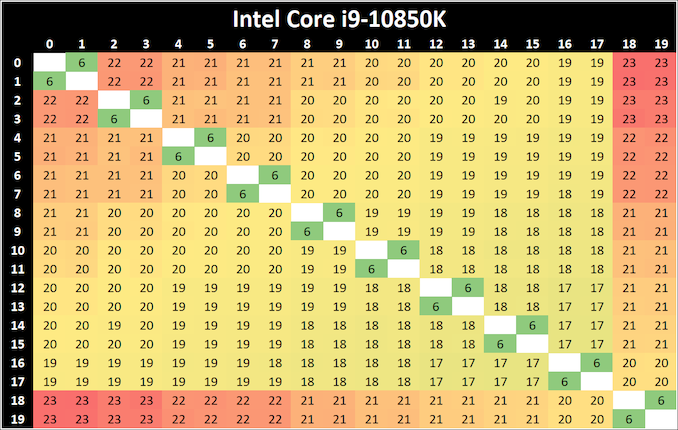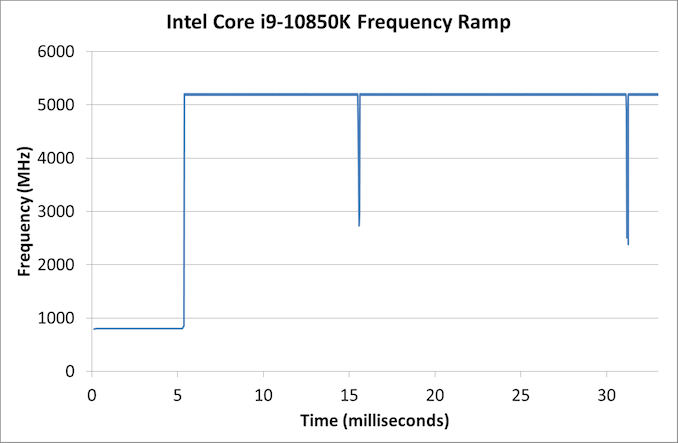Intel Core i9-10850K Review: The Real Intel Flagship
by Dr. Ian Cutress on January 4, 2021 9:00 AM EST- Posted in
- CPUs
- Intel
- Core
- Z490
- 10th Gen Core
- Comet Lake
- LGA1200
- i9-10850K
CPU Tests: Microbenchmarks
Core-to-Core Latency
As the core count of modern CPUs is growing, we are reaching a time when the time to access each core from a different core is no longer a constant. Even before the advent of heterogeneous SoC designs, processors built on large rings or meshes can have different latencies to access the nearest core compared to the furthest core. This rings true especially in multi-socket server environments.
But modern CPUs, even desktop and consumer CPUs, can have variable access latency to get to another core. For example, in the first generation Threadripper CPUs, we had four chips on the package, each with 8 threads, and each with a different core-to-core latency depending on if it was on-die or off-die. This gets more complex with products like Lakefield, which has two different communication buses depending on which core is talking to which.
If you are a regular reader of AnandTech’s CPU reviews, you will recognize our Core-to-Core latency test. It’s a great way to show exactly how groups of cores are laid out on the silicon. This is a custom in-house test built by Andrei, and we know there are competing tests out there, but we feel ours is the most accurate to how quick an access between two cores can happen.
When we first reviewed the 10-core Comet Lake processors, we noticed that a core (or two) seemed to take slightly longer to ping/pong than the others. We see the same pattern here again with the final core.
Frequency Ramping
Both AMD and Intel over the past few years have introduced features to their processors that speed up the time from when a CPU moves from idle into a high powered state. The effect of this means that users can get peak performance quicker, but the biggest knock-on effect for this is with battery life in mobile devices, especially if a system can turbo up quick and turbo down quick, ensuring that it stays in the lowest and most efficient power state for as long as possible.
Intel’s technology is called SpeedShift, although SpeedShift was not enabled until Skylake.
One of the issues though with this technology is that sometimes the adjustments in frequency can be so fast, software cannot detect them. If the frequency is changing on the order of microseconds, but your software is only probing frequency in milliseconds (or seconds), then quick changes will be missed. Not only that, as an observer probing the frequency, you could be affecting the actual turbo performance. When the CPU is changing frequency, it essentially has to pause all compute while it aligns the frequency rate of the whole core.
We wrote an extensive review analysis piece on this, called ‘Reaching for Turbo: Aligning Perception with AMD’s Frequency Metrics’, due to an issue where users were not observing the peak turbo speeds for AMD’s processors.
We got around the issue by making the frequency probing the workload causing the turbo. The software is able to detect frequency adjustments on a microsecond scale, so we can see how well a system can get to those boost frequencies. Our Frequency Ramp tool has already been in use in a number of reviews.
The Core i9-10850K ramps up extremely quickly from idle to peak turbo, in the region of about 5 milliseconds. This is faster than the 16 ms we typically observe.












126 Comments
View All Comments
Kevin G - Monday, January 4, 2021 - link
Inconsistency error on the second page: the 10850K and 10900K swap colors in the graphs.With regards to the intercore latency, what is the internal bus topology like in the 10 core Comet Lake? Last I heard, Intel was still using the ring topology for client processors but did they finally add a second ring similar to what they did for the medium and high core core count Xeons pre-Sky Lake? That'd explain why two of the cores seem off from the rest (and I would presume the GPU and PCIe controller would also sit on that same ring).
Spunjji - Monday, January 4, 2021 - link
I genuinely appreciate the detail put into this article, but it's amusing that it was prompted by what amounts to little more than a bait-and-switch on their top-end product. 😬 The way I'm looking at it, they either used the early reviews to lie about the price of their *theoretical* flagship CPU, or they used the early reviews to lie about the power characteristics of their *actually available* flagship CPU.Either way, the end result remains the same: never trust Intel PR, and avoid their products unless you like to use your PC as a small household water heater.
JessNarmo - Monday, January 4, 2021 - link
All companies lie and do questionable stuff, all that matters is what you getting for the money.And in winter small house heater in much appreciated when running script overnight allows you to avoid using house air heater in the room ;D
I think 10850k could be a pretty good deal if $400 or cheaper and you can't wait for AMD availability.
But I think it's only viable option for those who still rocking DDR3 or those who have no PC at all for the rest of us waiting is better. CPU upgrade is just not worth it as long as you have anything Skylake based on zen2 based.
Qasar - Tuesday, January 5, 2021 - link
" All companies lie and do questionable stuff " not compared to intel, they have been pretty much lieing for how many years now about how its 10nm tech is coming along.GeoffreyA - Wednesday, January 6, 2021 - link
Maybe Intel should go into the geyser business ;)zamroni - Monday, January 4, 2021 - link
Intel should remove the low spec on die integrated gpu and replace it with more powerful gpu chiplet.JessNarmo - Monday, January 4, 2021 - link
Intel should remove integrated GPU from all high end CPU's. It's completely pointless. No one is using $500 CPU and using integrated graphics. Silicone is better spent on better CPU.heftig - Monday, January 4, 2021 - link
I am, actually. For a soho+media server and distcc host which only needs a GPU for whatever can't be done over SSH.temps - Monday, January 4, 2021 - link
good to see anandtech still has the biggest gap between quality of articles and quality of comment sectionrunning a 9900K with integrated here, the computer is for audio production and has no use for a graphics card. intel outperforms ryzen for this workload too.
powerarmour - Tuesday, January 5, 2021 - link
Sorry to disappoint if you've been hiding under a rock for a couple of years, but this is no longer the case, check any recent Scan dawbench articles...